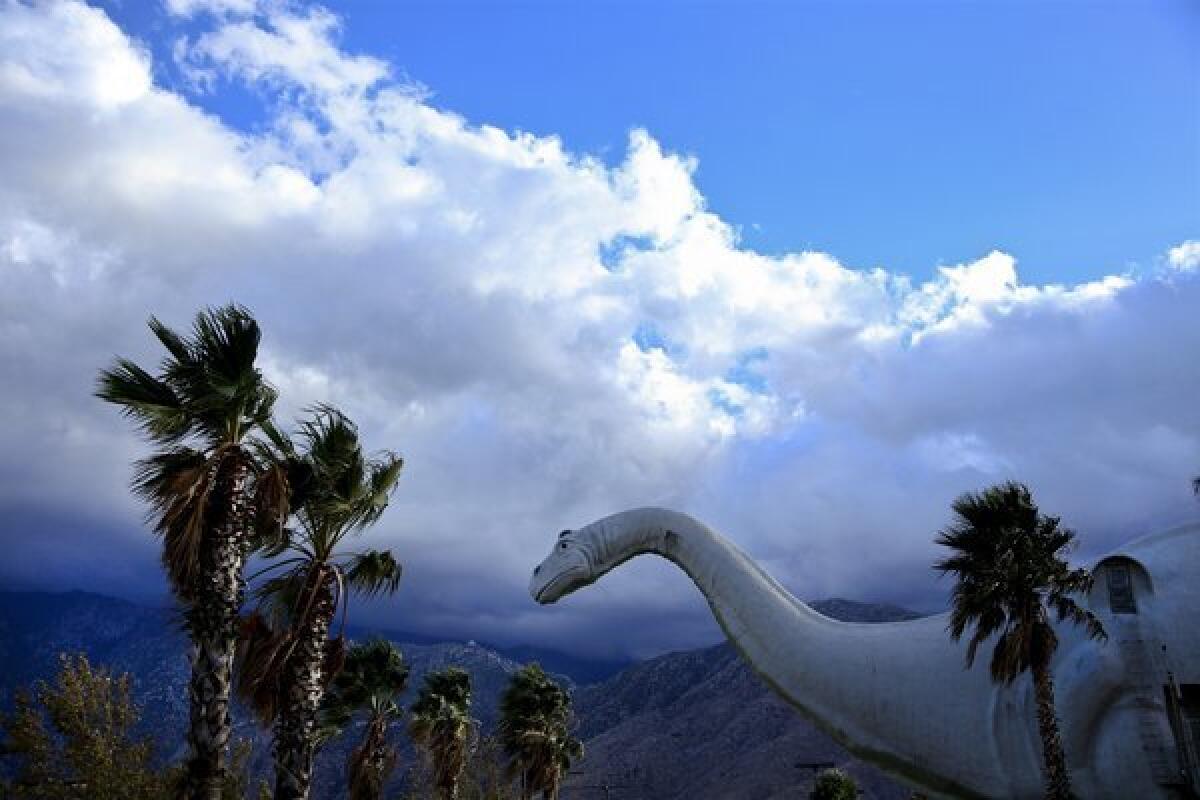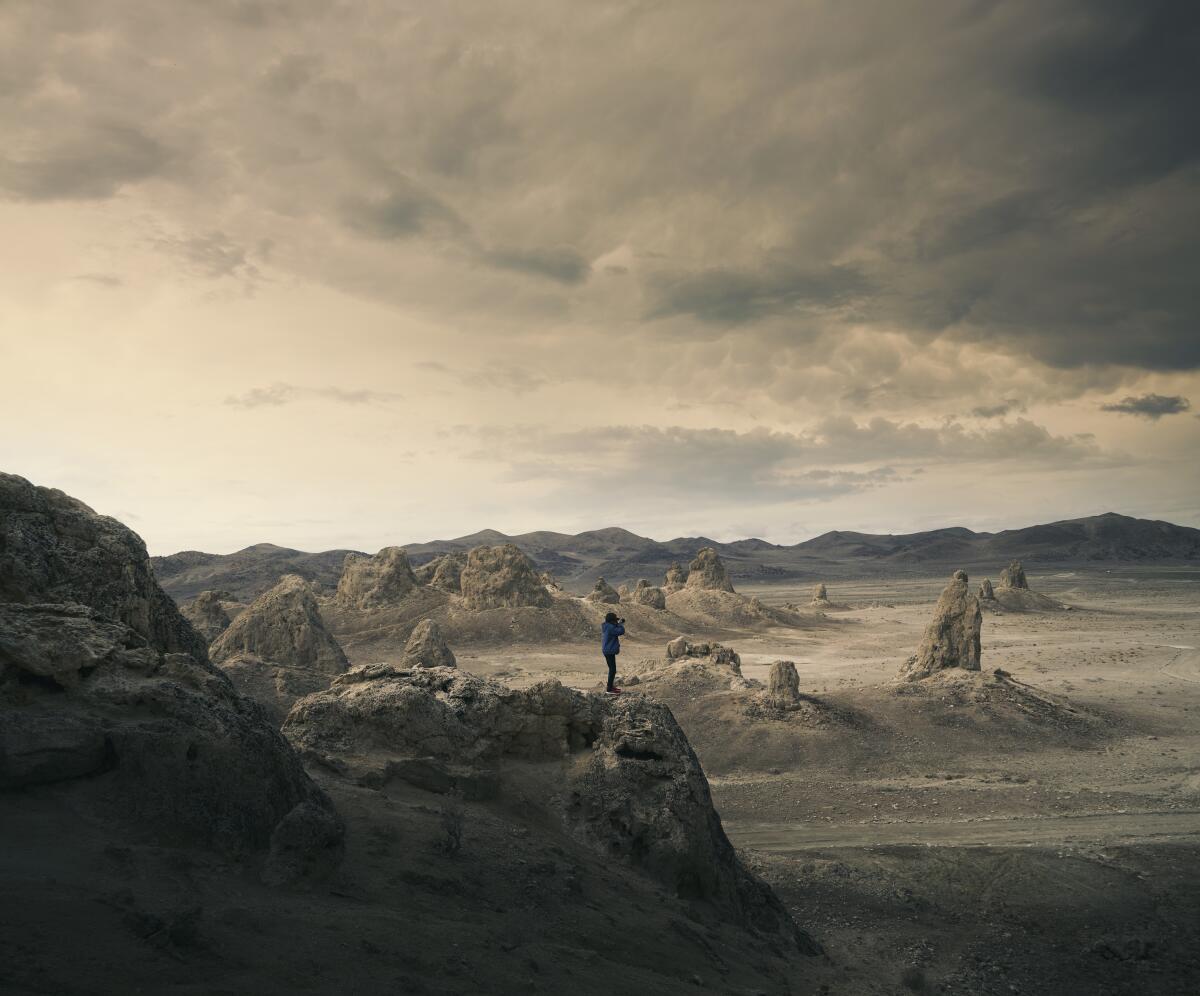6 stops on your California desert literary road trip (dinosaurs included)

- Share via
Mary Austin called it the land of little rain. In her 1903 book of that name, she wrote of the Mojave: “This is the land of three seasons.”
“From June on to November it lies hot, still, and unbearable … then on until April, chill, quiescent, drinking its scant rain and scanter snows; from April to the hot season again, blossoming, radiant and seductive.”
California’s literature of the desert begins in many ways with Austin, who was born in Illinois and moved west at 20, in 1888. “She was a beautiful writer about a place people had written off,” says Ken Layne, the Joshua Tree-based editor of “Desert Oracle” — a quarterly digest he has called “a pocket field guide to the strange and mysterious Mojave” — and host of “Desert Oracle Radio.”
At the same time, Austin was not alone. “Writers and poets and artists and performers have been moving to the California desert for over a century at this point,” Layne says, “away from the polluting or corrupting influence of cities such as Los Angeles.” That distance may have narrowed over the last 100 years, with the advent of sprawl and Wi-Fi and the freeway system, but the desert continues to exert itself.
Edmund C. Jaeger Nature Sanctuary
To start your literary journey, Layne recommends Edmund C. Jaeger, “a pioneering desert biologist” known for his work on desert flora and fauna. Jaeger, a contemporary of Austin’s, arrived in Riverside in 1907 and became, in Layne’s words, “an early resident of the Palm Canyon bohemian community.”
Read Jaeger’s work and visit the nature sanctuary named in his honor. His “Desert Wild Flowers” is still regarded as among the most incisive guides on the subject. In the late 1940s, he became the first naturalist to observe “profound torpidity” — a state like hibernation — in birds while studying the poorwill in the Chuckwalla Mountains southeast of Desert Center. The site became a nature sanctuary in 1986, three years after his death at 96.
Info: South of I-10, southeast of Desert Center, in the Chuckwalla Mountains; (951) 697-5200; blm.gov/visit/chuckwalla-mountains-wilderness
Road read: “Desert Wild Flowers” by Edmund C. Jaeger (Stanford University Press, 1940)
Cabazon dinosaurs
In his 1988 novel “Los Angeles Without a Map,” Richard Rayner describes a trip to the desert. Along the way, his bewildered narrator confronts an enormous dinosaur: “green, made from shaped fiberglass and … over 150 feet tall.” This is one of the Cabazon dinosaurs, a roadside attraction west of Palm Springs completed in 1975 as a come-on for a local restaurant. Rayner’s novel offers an insightful skewering of Hollywood in the vein of Joan Didion’s “Play It As It Lays” (1970) and Eve Babitz’s “Slow Days, Fast Company” (1977), both of which also feature desert reckonings.
“When I think of writing about the desert,” says novelist Tod Goldberg, “it is very rarely about the cities, but about the land where the actual desert lives.”
Info: 50770 Seminole Drive, Cabazon; (951) 922-8700; 9 a.m.-8 p.m. Monday-Sunday. cabazondinosaurs.com
Road read: “Los Angeles Without a Map” by Richard Rayner (Mariner Books, 1988)
Arts & Letters Author Series
Like Layne, Goldberg understands the desert. The stories in his 2009 collection “Other Resort Cities” take place in outposts ranging from Las Vegas to the Salton Sea. He also directs the low-residency MFA in creative writing at UC Riverside’s Palm Desert Center and since 2007 has run its Arts & Letters Author Series. (Full disclosure: I teach in the program and have appeared in the author series.)
“We host these events for free,” he says, “because all other author events in the valley cost money and it’s my view that young people and people who cannot afford to pay to see a writer talk should not be prohibited.” Guest writers include Susan Straight, Molly Ringwald, Susan Orlean and Laila Lalami, whose 2019 novel, “The Other Americans,” unfolds in nearby Yucca Valley and explores the lines of intersection and conflict in the wake of a hit-and-run.
Info: 75080 Frank Sinatra Drive, Palm Desert; (760) 834-0800; check website for schedule. palmdesert.ucr.edu/arts-and-letters-lecture-series
Road read: “The Other Americans” by Laila Lalami (Pantheon, 2019); “Other Resort Cities,” by Tod Goldberg (OV Books, 2009)

Pappy & Harriet’s
About six miles from Yucca Valley, Pioneertown brings a Hollywood fantasy to life. Built in 1946 as a set for westerns, it lingers as what Mark Haskell Smith calls in his 2013 novel “Raw,” “some kind of 1870s Wild West way station, a hardscrabble burg carved out of the sun-blasted desert and populated by rattle snakes, roadrunners, and their human equivalents.”
Smith’s novel revolves around such a cast of characters, including a book blogger who kills a novelist then dumps the body at the Pioneertown Motel, behind Pappy & Harriet’s, a roadhouse that since 1982 has hosted performers including Lucinda Williams, Robert Plant and Paul McCartney.
Info: 53688 Pioneertown Road, Pioneertown; (760) 365-5956; Monday, 5-9:30 p.m., Thursday-Saturday, 11 a.m.-2 a.m., Sunday, 11a.m.-9:30p.m. pappyandharriets.com
Road read: “Raw” by Mark Haskell Smith (Grove, 2013)

Trona Pinnacles
Hari Kunzru’s “Gods Without Men” moves through time and space like a trickster, invoking mythologies ancient and contemporary. Much of the novel takes place around Twentynine Palms, on the other side of Yucca Valley. But the heart of the book involves a UFO cult that sets up camp at a spot called the Pinnacles, where “columns of rock shot up like the tentacles of some ancient creature, weathered feelers probing the sky.”
Kunzru’s Pinnacles are an invention, but they recall the Trona Pinnacles, which according to the Bureau of Land Management, “consists of more than 500 tufa spires, some as high as 140 feet, rising from the bed of the Searles Dry Lake basin,” just south of Death Valley National Park. It’s a long drive — 192 miles north of Twentynine Palms — but that only reminds us how vast the desert is.
Info: 20 miles east of Ridgecrest; (760) 384-5400; call for availability blm.gov/visit/trona-pinnacles
Road read: “Gods Without Men” by Hari Kunzru (Knopf, 2011)
Bombay Beach
The vastness remains a defining feature. Drive 110 miles south from Twentynine Palms and you’ll find the Salton Sea and Bombay Beach — a “desert outpost,” Marisa Silver writes in her 2008 novel “The God of War” “… like a child who has found himself such a good hiding spot that he unintentionally exiles himself from the game.” The image echoes Layne’s description of the early bohemians.
Bombay Beach has long been attractive to artists; since 2015 it’s hosted the Bombay Beach Biennale, billed as a “renegade celebration of art, music and philosophy.” Now writers Gina Frangello and Rob Roberge are putting together a library, and a festival called Lit Week. “If you’re someone who roots for the underdog,” Frangello insists, “you can’t help wanting the residents of Bombay Beach to thrive.”
Info: Bombay Beach Library, 25035 Woodward Ave., Lomita; library will open with Lit Week, March 23-29, 2020.
Road read: “The God of War” by Marisa Silver (Simon & Schuster, 2008)
Ulin is a former books editor and book critic of The Times.
More to Read
Sign up for our Book Club newsletter
Get the latest news, events and more from the Los Angeles Times Book Club, and help us get L.A. reading and talking.
You may occasionally receive promotional content from the Los Angeles Times.








